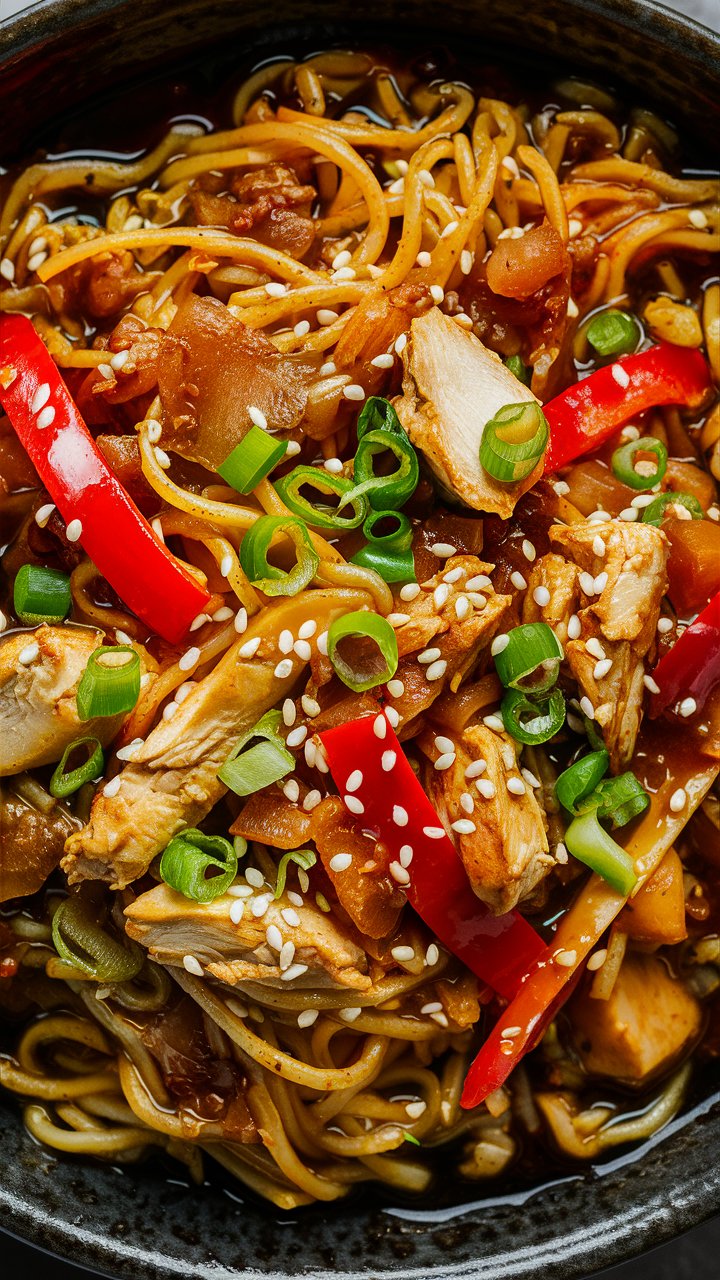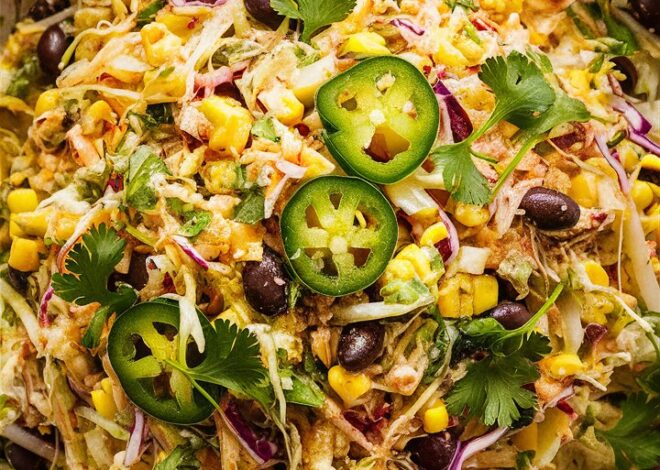
Authentic Chicken Chow Mein: Step-by-Step Instructions 2025
Few dishes manage to capture the heart of home cooks and takeout lovers alike the way Chicken Chow Mein does. With its glossy noodles, tender chicken, crunchy vegetables, and savory umami-packed sauce, this Chinese-inspired classic has become a global comfort food.
But did you know that the version you enjoy from your local takeout spot isn’t the only way to prepare chow mein? In fact, there are countless ways to customize it—different vegetables, proteins, and sauces—while still keeping that irresistible balance of textures and flavors.
This article is your complete guide to making Chicken Chow Mein at home. Whether you’re a beginner in the kitchen or a seasoned cook looking to perfect your stir-fry skills, this step-by-step recipe and deep dive will help you master the dish while giving you confidence to add your own flair.
By the end, you’ll know:
- The history and background of chow mein.
- The exact ingredients you need (and what to substitute).
- Professional cooking techniques for authentic stir-fry flavor.
- Variations, serving suggestions, and storage methods.
- Pro tips for making it better than takeout.
So, grab your wok (or a large skillet) and let’s get started.
What is Chicken Chow Mein?
The term “chow mein” comes from the Cantonese phrase chāu-mèing, which translates to “stir-fried noodles.” It’s a dish that originated in China and spread across the world, becoming especially popular in Chinese-American restaurants.
At its core, chow mein consists of:
- Protein (in this case, chicken).
- Vegetables (such as cabbage, carrots, bell peppers, and bean sprouts).
- Egg noodles (fresh or dried).
- Sauce (a mix of soy sauce, oyster sauce, sesame oil, and aromatics).
Unlike lo mein (which uses softer, saucy noodles), chow mein is stir-fried at high heat, giving the noodles a slightly chewy texture and sometimes even crispy edges.
When done correctly, every bite should be balanced: savory sauce clinging to noodles, chicken that’s juicy and golden, and vegetables that are tender but still vibrant.
Why Make Chicken Chow Mein at Home?
While takeout is convenient, homemade chow mein has several advantages:
- Healthier ingredients – You control the oil, sodium, and freshness.
- Customizable – Add more vegetables, adjust the spice, or swap proteins.
- Budget-friendly – A big batch costs much less than ordering from a restaurant.
- Fresher flavor – Straight from your wok to the table, no delivery wait time.
- Cooking skill booster – Stir-frying teaches timing, knife skills, and flavor balance.
Once you try this recipe, you might never crave takeout again.
Ingredients You’ll Need
Here’s a breakdown of the essential ingredients for authentic Chicken Chow Mein:
For the Chicken
- Chicken breast or thighs – Boneless and skinless, sliced thinly for quick cooking.
- Oil – A neutral oil with a high smoke point, such as canola or vegetable oil.
For the Vegetables
- Cabbage – Adds crunch and sweetness.
- Carrots – Julienned for color and freshness.
- Green onions (scallions) – A classic aromatic.
- Garlic – Essential for depth of flavor.
- Optional add-ins: bell peppers, snow peas, bean sprouts, or mushrooms.
For the Noodles
- Chow mein noodles – Fresh if available, dried if not.
- Alternatives: yakisoba noodles, egg noodles, or even spaghetti in a pinch.
For the Sauce
- Soy sauce (light) – Provides saltiness and depth.
- Oyster sauce – Adds rich umami flavor.
- Chicken broth – Keeps the sauce glossy and smooth.
- Sesame oil (light, not toasted) – For subtle nutty aroma.
- Cornstarch – Thickens the sauce so it clings to the noodles.
- Sugar (a pinch) – Balances the saltiness.
Step-by-Step Instructions
Step 1: Prepare the Sauce
In a small bowl, whisk together:
- 2 tablespoons oyster sauce
- 3 tablespoons low-sodium soy sauce
- ½ teaspoon sugar
- 1 teaspoon light sesame oil
- ½ cup chicken broth
- 1 teaspoon cornstarch
Whisk until smooth. Set aside.
Step 2: Cook the Noodles
- Boil noodles according to package directions until just al dente.
- Drain and rinse under cold water to stop cooking.
- Toss with a teaspoon of oil to prevent sticking.
Step 3: Cook the Chicken
- Heat a wok or large skillet over medium-high heat.
- Add 1 tablespoon oil.
- Stir-fry sliced chicken until golden brown and cooked through.
- Transfer to a plate.
Step 4: Stir-Fry the Vegetables
- Add another tablespoon of oil if needed.
- Sauté garlic for 20 seconds.
- Add carrots and cabbage. Stir-fry for 2–3 minutes until slightly tender.
Step 5: Combine Everything
- Return chicken to the pan.
- Add cooked noodles.
- Pour sauce over and toss quickly to coat.
- Stir-fry for another 2 minutes until sauce thickens and everything is hot.
Step 6: Garnish and Serve
Top with chopped green onions and serve hot.
Pro Tips for the Best Chow Mein
- Prep first: Have all ingredients ready; stir-frying is fast.
- Don’t overcook noodles: They’ll soften more in the pan.
- Use high heat: It gives that restaurant-style “wok hei” flavor.
- Slice chicken thinly: Ensures tenderness and quick cooking.
- Avoid overcrowding: Cook in batches if necessary.
Variations and Substitutions
- Protein swaps: Shrimp, beef, pork, or tofu.
- Vegetable boosts: Add bok choy, bean sprouts, mushrooms, or bell peppers.
- Spicy version: Add chili paste, sriracha, or red pepper flakes.
- Gluten-free: Use tamari instead of soy sauce and rice noodles instead of egg noodles.
- Low-carb: Try spiralized zucchini or shirataki noodles.
What to Serve with Chicken Chow Mein
Pairing sides can turn chow mein into a full feast:
- Appetizers: Spring rolls, dumplings, or wonton soup.
- Rice dishes: Steamed jasmine rice, egg fried rice, or garlic fried rice.
- Fresh sides: Asian cucumber salad, pickled radish, or sesame spinach.
- Beverages: Green tea, jasmine tea, or even a light sparkling drink.
- Dessert: Fresh fruit platter, sesame balls, or mango pudding.
Nutritional Information (per serving, approx.)
- Calories: 420
- Protein: 28 g
- Carbohydrates: 48 g
- Fat: 12 g
- Fiber: 4 g
- Sodium: 890 mg
(Values will vary based on portion size and ingredients used.)
Storage and Leftovers
- Refrigerator: Store in an airtight container for up to 3 days.
- Freezer: Not recommended (noodles turn mushy).
- Reheating: Warm in a skillet with a splash of water or broth, or microwave in short intervals.
Frequently Asked Questions (FAQs)
Q1: Can I make Chicken Chow Mein without oyster sauce?
Yes. Use hoisin sauce or extra soy sauce with a pinch of sugar for sweetness.
Q2: What’s the difference between chow mein and lo mein?
Chow mein is stir-fried with less sauce, giving a slightly crispy or chewy noodle texture. Lo mein is softer and more saucy.
Q3: Can I use leftover chicken?
Absolutely. Rotisserie chicken or pre-cooked grilled chicken works well. Just add it when combining with noodles and sauce.
Q4: Can I make this dish ahead of time?
You can prep ingredients and even make the sauce in advance. Cook fresh for best results.
Q5: How do I keep noodles from sticking?
Rinse in cold water after boiling and toss with oil before stir-frying.
Q6: Can I double the recipe?
Yes, but use a larger wok or cook in batches to prevent overcrowding.
Final Thoughts
Chicken Chow Mein is more than just a quick dinner—it’s a canvas for creativity, flavor, and family enjoyment. By learning the foundations of this dish, you can transform simple ingredients into a meal that tastes just as good (if not better) than restaurant takeout.
Whether you stick to the classic version or experiment with your favorite vegetables and sauces, the beauty of chow mein lies in its versatility. Once you try this recipe, it will likely become a regular in your kitchen rotation.
So the next time you’re tempted to call for delivery, remember: you can whip up a big pan of Chicken Chow Mein at home in less than 30 minutes, with fresher flavor and a fraction of the cost.

